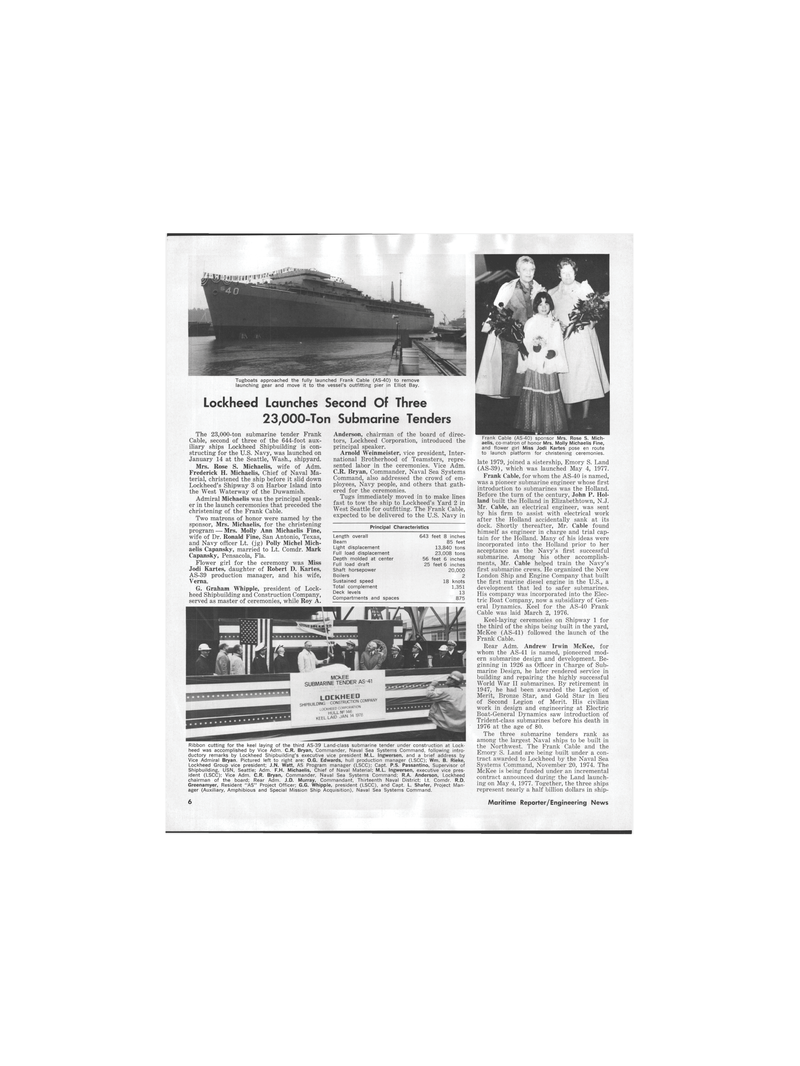
Page 4: of Maritime Reporter Magazine (March 1978)
Read this page in Pdf, Flash or Html5 edition of March 1978 Maritime Reporter Magazine
MCKEE
SUBMARINE TENDER AS-41
KEEL lA^JAN 14 1976
Tugboats approached the fully launched Frank Cable (AS-40) to remove launching gear and move it to the vessel's outfitting pier in Elliot Bay.
Lockheed Launches Second Of Three 23,000-Ton Submarine Tenders late 1979, joined a sistership, Emory S. Land (AS-39), which was launched May 4, 1977.
Frank Cable, for whom the AS-40 is named, was a pioneer submarine engineer whose first introduction to submarines was the Holland.
Before the turn of the century, John P. Hol- land built the Holland in Elizabethtown, N.J.
Mr. Cable, an electrical engineer, was sent by his firm to assist with electrical work after the Holland accidentally sank at its dock. Shortly thereafter, Mr. Cable found himself as engineer in charge and trial cap- tain for the Holland. Many of his ideas were incorporated into the Holland prior to her acceptance as the Navy's first successful submarine. Among his other accomplish- ments, Mr. Cable helped train the Navy's first submarine crews. He organized the New
London Ship and Engine Company that built the first marine diesel engine in the U.S., a development that led to safer submarines.
His company was incorporated into the Elec- tric Boat Company, now a subsidiary of Gen- eral Dynamics. Keel for the AS-40 Frank
Cable was laid March 2, 1976.
Keel-laying ceremonies on Shipway 1 for the third of the ships being built in the yard,
McKee (AS-41) followed the launch of the
Frank Cable.
Rear Adm. Andrew Irwin McKee, for whom the AS-41 is named, pioneered mod- ern submarine design and development. Be- ginning in 1926 as Officer in Charge of Sub- marine Design, he later rendered service in building and repairing the highly successful
World War II submarines. By retirement in 1947, he had been awarded the Legion of
Merit, Bronze Star, and Gold Star in lieu of Second Legion of Merit. His civilian work in design and engineering at Electric
Boat-General Dynamics saw introduction of
Trident-class submarines before his death in 1976 at the age of 80.
The three submarine tenders rank as among the largest Naval ships to be built in the Northwest. The Frank Cable and the
Emory S. Land are being built under a con- tract awarded to Lockheed by the Naval Sea
Systems Command, November 20, 1974. The
McKee is being funded under an incremental contract announced during the Land launch- ing on May 4, 1977. Together, the three ships represent nearly a half billion dollars in ship-
Ribbon cutting for the keel laying of the third AS-39 Land-class submarine tender under construction at Lock- heed was accomplished by Vice Adm. C.R. Bryan, Commander, Naval Sea Systems Command, following intro- ductory remarks by Lockheed Shipbuilding's executive vice president M.L. Ingwersen, and a brief address by
Vice Admiral Bryan. Pictured left to right are: O.G. Edwards, hull production manager (LSCC); Wm. B. Rieke,
Lockheed Group vice president; J.N. Watt, AS Program manager (LSCC); Capt. P.S. Passantino, Supervisor of
Shipbuilding, USN, Seattle; Adm. F.H. Michaelis, Chief of Naval Material; M.L. Ingwersen, executive vice pres- ident (LSCC); Vice Adm. C.R. Bryan, Commander, Naval Sea Systems Command; R.A. Anderson, Lockheed chairman of the board; Rear Adm. J.D. Murray, Commandant, Thirteenth Naval District; Lt. Comdr. R.D.
Greenamyer, Resident "AS" Project Officer; G.G. Whipple, president (LSCC), and Capt. L. Shafer, Project Man- ager (Auxiliary, Amphibious and Special Mission Ship Acquisition), Naval Sea Systems Command.
The 23,000-ton submarine tender Frank
Cable, second of three of the 644-foot aux- iliary ships Lockheed Shipbuilding is con- structing for the U.S. Navy, was launched on
January 14 at the Seattle, Wash., shipyard.
Mrs. Rose S. Michaelis, wife of Adm.
Frederick H. Michaelis, Chief of Naval Ma- terial, christened the ship before it slid down
Lockheed's Shipway 3 on Harbor Island into the West Waterway of the Duwamish.
Admiral Michaelis was the principal speak- er in the launch ceremonies that preceded the christening of the Frank Cable.
Two matrons of honor were named by the sponsor, Mrs. Michaelis, for the christening program — Mrs. Molly Ann Michaelis Fine, wife of Dr. Ronald Fine, San Antonio, Texas, and Navy officer Lt. (jg) Polly Michel Mich- aelis Capansky, married to Lt. Comdr. Mark
Capansky, Pensacola, Fla.
Flower girl for the ceremony was Miss
Jodi Kartes, daughter of Robert D. Kartes,
AS-39 production manager, and his wife,
Verna.
G. Graham Whipple, president of Lock- heed Shipbuilding and Construction Company, served as master of ceremonies, while Roy A.
Anderson, chairman of the board of direc- tors, Lockheed Corporation, introduced the principal speaker.
Arnold Weinmeister, vice president, Inter- national Brotherhood of Teamsters, repre- sented labor in the ceremonies. Vice Adm.
C.R. Bryan, Commander, Naval Sea Systems
Command, also addressed the crowd of em- ployees, Navy people, and others that gath- ered for the ceremonies.
Tugs immediately moved in to make lines fast to tow the ship to Lockheed's Yard 2 in
West Seattle for outfitting. The Frank Cable, expected to be delivered to the U.S. Navy in
Principal Characteristics
Length overall 643 feet 8 inches
Beam 85 feet
Light displacement 13,840 tons
Full load displacement 23,008 tons
Depth molded at center 56 feet 6 inches
Full load draft 25 feet 6 inches
Shaft horsepower 20,000
Boilers 2
Sustained speed 18 knots
Total complement 1,351
Deck levels 13
Compartments and spaces 875
Frank Cable (AS-40) sponsor Mrs. Rose S. Mich- aelis, co-matron of honor Mrs. Molly Michaelis Fine, and flower girl Miss Jodi Kartes pose en route to launch platform for christening ceremonies. 6 Maritime Reporter/Engineering News

 3
3

 5
5
